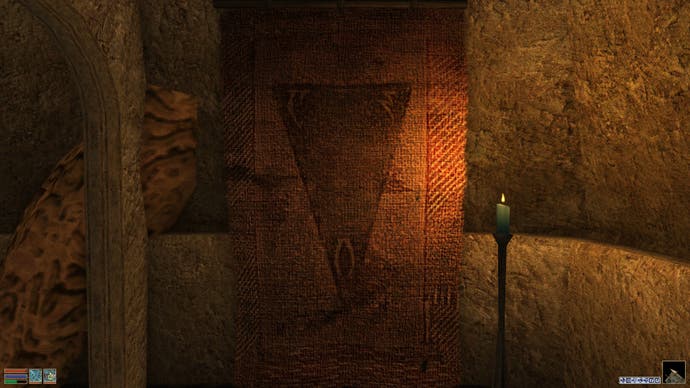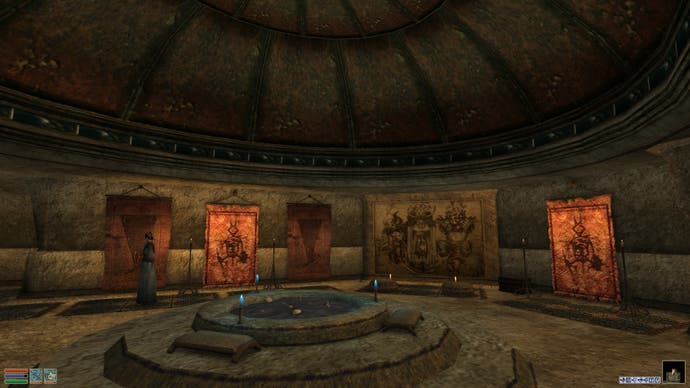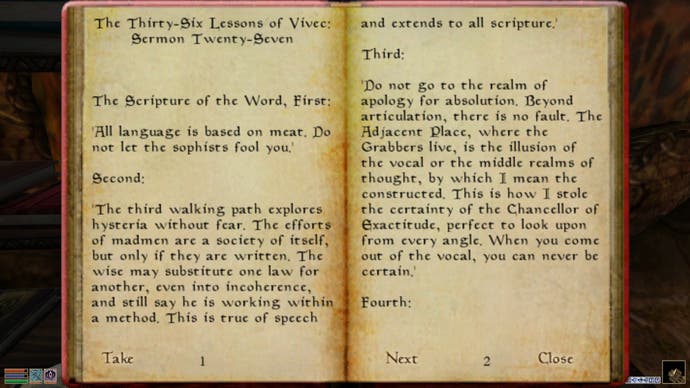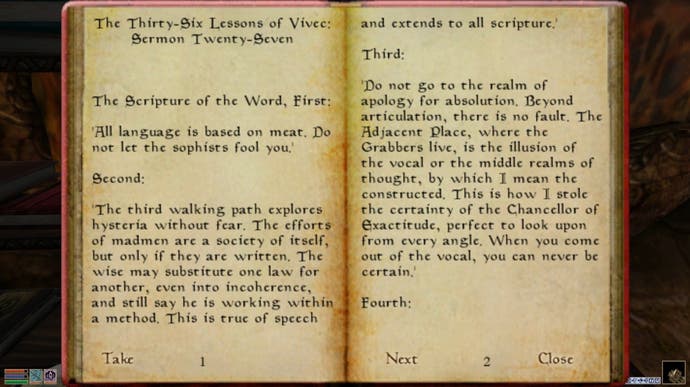The brilliant weirdness of Morrowind's in-game books
Letters written in uncertainty.
"You can hear the words, so run away
"Come Hortator, unfold into a clear unknown,
"Stay quiet until you've slept in the yesterday,
"And say no elegies for the melting stone." - The 36 Lessons of Vivec, Sermon 5

If there's one example of video game flavour text that adds much more than flavour, it's the in-game books of The Elder Scrolls 3: Morrowind. I remember the first time I entered one of the libraries of Vvardenfell (17 years ago!) and was overwhelmed by the ancient tomes; not just the sheer amount of information, but more importantly their evocative strangeness. One work stood out to me even then: The 36 Lessons of Vivec, composed by the hermaphrodite warrior-poet Vivec (aka Vehk), one of Morrowind's living gods. They seemed like complete gibberish to me back then, and it didn't help that the Lessons, contained in 36 volumes and dispersed across Vvardenfell, are often encountered out of their proper order.
Written by ex-Bethesda designer Michael Kirkbride, The 36 Lessons are Vivec's own account of their strange birth, life and ascension to godhood as a member of the Tribunal (or ALMSIVI), the three god-kings of Morrowind. As their title suggests, they also contain Vivec's wisdom and philosophies, some of which seems to be intended for none other than the Nerevarine, the anticipated reincarnation of Vivec's first saint Nerevar, called the Hortator. Anyone who's played Morrowind knows it is the player character themselves who's suspected of being the Nerevarine, and most of the main story revolves around confirming this suspicion to all the factions of Vvardenfell. In a way, then, the Lessons often seem to speak directly to us as protagonists of the game.

Are they trying to teach us, or to manipulate us? It can be hard to tell. The Lessons are often dense and obtuse, and they draw on and allude to numerous texts both in-game and from outside of it. As has been pointed out by people more learned in Morrowind lore than I am , its style and substance is influenced by Hindu texts such as the Bhagavad Gita or the Ramayana, and some passages quote the poetry of W. B. Yeats and the occultist writing of Aleister Crowley.
The Lessons owe a debt to a wide range of different kinds of (mostly) religious, esoteric and mythological writing. The individual lessons are called sermons. Some of Vivec's sayings resemble proverbs or parables. There are many prophetic passages, anticipating, for example, the coming of the Nerevarine. Its narratives of confrontations, transformations, deceptions, begettings, creations and destructions echo the language and tropes of myths. Many of these myths are etiological, meaning they are 'origin myths' that try to explain how something came to be. The Lessons not only tell of Vivec's own 'birth' in the form of an egg, but also relate how their city (also called Vivec) was erected on top of the bones of one of Vivec's demonic offspring, Horde Mountain (Sermon 24), and how another one called Lie Rock became the floating rock suspended over the city (Sermon 33).

Esoteric and hermetic traditions are especially strong in the Lessons. Word magic plays a major role in the stories, and some oft-repeated phrases, such as "The ending of the words is ALMSIVI", which concludes (almost) every sermon, feel like incantations. Echoes of esoteric ideas like emanations can be seen in the 'unfoldings' taking place in the Lessons, entities hiding other entities within themselves. Most of the symbols in the Lessons have clear parallels in the long history of hermetic writing, such as the (cosmic) egg, the sword, the tower, water and fire, the planets (sometimes appearing as spirits or gods), human features like the eye or the hand, the wheel, as well as basic geometric shapes like circles, triangles, crosses and stars.

The Lessons' vivid, almost hallucinogenic imagery is reminiscent of the Book of Revelations, which describes John of Patmos' vision of the last days. Take the weirdness of Revelations 9:7 (King James translation): "And the shapes of the locusts were like unto horses prepared unto battle; and on their heads were as it were crowns like gold, and their faces were as the faces of men." Many of the passages from Revelations puzzle its reader in a similar way as the Lessons, in the sense they may look like nonsense at first but also hint at deeper meanings just beyond the surface level that might reveal themselves if only you looked hard enough. Why does the beast need a number, and why is it six hundred and sixty six (13:18)? What on earth is "the beast that was, and is not, and yet is" (17:8)? And what's with the angel telling John to eat a "little book" which "shall make thy belly bitter, but it shall be in thy mouth sweet as honey"(10:9)?
There are more subtle parallels as well. Numbers with uncertain meaning are important in both texts. The Lessons state, for example: "The Son is myself, Vehk, and I am unto three, six, nine, and the rest that come after", or "I am Vehk, your protector and the protector of Red Mountain until the end of days, which are numbered 3333" (Sermon 6). Both share a vivid interest in celestial bodies and their symbolic values. Beyond Revelations, the Lessons resonate with many aspects of Christian theology. The Tribunal, three facets of a whole, recall the Holy Trinity of father, son and holy spirit. Just as esoteric is the idea of anticipations: The Daedra Prince Mephala, for example, is sometimes referred to as the anticipation of Vivec. This resonates with the idea of typology or prefiguration, which states characters from the Old Testament anticipate characters from the New Testament. The sacrifice of Isaac, for example, was often understood as a prefiguration of the death of Christ.

One of the most striking things about the Lessons is it has spawned a still ongoing and painstaking process of interpretation. In this digital and comparatively secular age, lore scholars have written a daunting amount of commentaries and even annotated versions of the Lessons , an undertaking that's very much in line with the millennia-old tradition of Biblical exegesis.
This would be enough to make the literature and lore of Morrowind unique among video games, but it's only half of the story. The Lessons aren't merely a faithful reconfiguration of old traditions and genres. In fact, their use of old tropes is in many ways (post)modern and subversive.
The main reason for this is that meaning, writing and interpretation itself is one of the main themes of the Lessons. In other words, it self-consciously thematises our struggles to understand the text, often in an almost tongue-in-cheek manner. Nerevar, Vivec's pupil, is often shown as hopelessly confused by his master's obtuse teachings: "The Hortator wandered through the Mourning Hold, wrestling with the lessons he had learned. They were slippery in his mind. He could not always keep the words straight and knew that this was a danger" (Sermon 16). Since our protagonist is seen as the reincarnation of Nerevar, Nerevar functions as a sort of stand-in for us as readers. His confusion is our confusion, and the Lessons anticipate our struggle to understand.

Meaning, the Lessons seem to tell us, isn't absolute but shifting and subjective. Early in the life of Vivec, when they were still an egg, they have an encounter with the spirit At-Hatoor:
"The third spirit, At-Hatoor, came down to the netchiman's wife while she relaxed for a while under an Emperor Parasol. His garments were made from implications of meaning, and the egg looked at them three times. The first time Vivec said:
"'Ha, it means nothing!'
"After looking a second time he said:
"'Hmm, there might be something there after all.'
"Finally, giving At-Hatoor's garments a sidelong glance, he said:
"'Amazing, the ability to infer significance in something devoid of detail!'
"'There is a proverb,' At-Hatoor said, and then he left." - Sermon 2
Again, the Lessons playfully acknowledge our own process of reading and interpreting the text. First, we see only gibberish. But then, looking again, we feel like perhaps we can guess at some of the text's deeper meaning. The Lessons may not be "devoid of detail", but this "proverb" is still true in the sense that our interpretations hinge just as much on what isn't said, the empty space between the lines, as it does on the very ambiguous text itself. Meaning is never fixed, never perfect or completed, and if it was, it would be dead and of no interest or use to anyone, least of all to Vivec. One of the main teachings of Vivec is creation and fertility comes only from chaos and flux, and stasis is just another word for death. The Lessons aren't a puzzle to be solved, because solving leads to stagnation and in turn to annihilation: "Vivec said, 'Now you are solved,' and pierced his child with Muatra. Moon Axle had been reduced to something static, and therefore shattered" (Sermon 20).

The spiritual necessity of ambiguity and uncertainty becomes clear in Vivec's curious verbal sparring with the Chancellor of Exactitude:
"Finally the Chancellor of Exactitude appeared, and he was perfect to look upon from every angle. Vivec understood the challenge immediately and said: 'Certitude is for the puzzle-box logicians and girls of white glamour who harbor it on their own time. I am a letter written in uncertainty.'
"The Chancellor bowed his head and smiled fifty different and perfect ways all at once. He pulled the astrolabe of the universe from his robe and broke it in half, handing both halves to the egg-image of Vivec." - Sermon 4
Vivec dismisses certitude as something trivial and beneath him. And if Vivec themselves are too complex for understanding, then the same must be true of their sermons. The point of the Lessons isn't to work towards a definitive understanding of them, but to continuously glean tentative facets of meaning, there one moment and gone the next. The Lessons show there's pleasure in not fully understanding, in accepting uncertainty and manifold implications. If it were otherwise, fans wouldn't still be studying and discussing these texts 17 years later.









